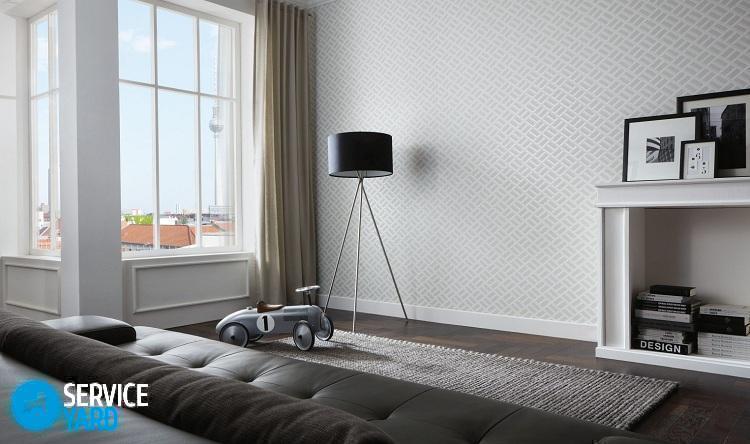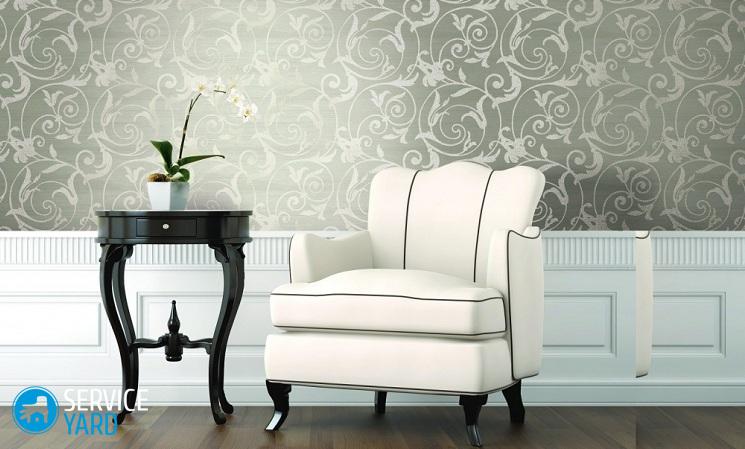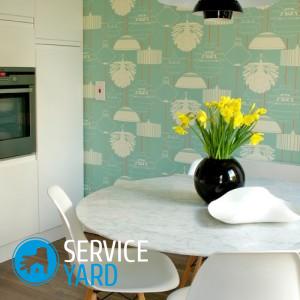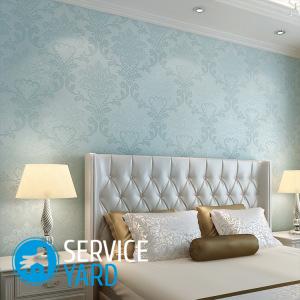How to glue non-woven meter wallpaper?
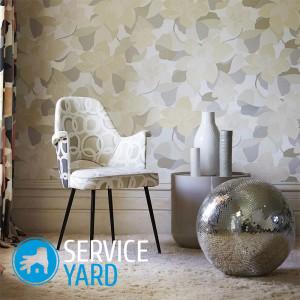
For people who decide to update the atmosphere in the room by gluing wallpapers, information on how to glue non-woven meter-long wallpapers will be more useful than ever. To use this particular type of wallpaper for the novice builder is an absolutely unexplored occupation, because earlier in most cases the walls were glued with standard widths of canvas. But in parallel there was a release and wallpaper of non-standard, meter-wide. Using this particular type of canvas, you will have to completely change the sequence of repairs in the room.
The material for the manufacture of meter paintings is practically no different from ordinary wallpaper, but the width of the finished products significantly saves time and personal efforts for pasting the wall. In our article, we will talk in detail about the features of choosing paintings, preparing a wall surface and how to glue wide wallpapers correctly.
to contents ↑Varieties of meter wallpaper
Most of the wallpaper products are produced strictly according to a certain standard - 53 cm wide. Products manufactured abroad have a wider range of products, but in most cases the wallpaper has non-standard sizes.
Here are a few examples:
- Wallpaper of German and Italian factories have a working canvas width of 70 cm or 106 cm.
- Belgian factories offer wallpaper roll width 90 centimeters, 100 cm or 140 cm.
- French manufacturers sell their products in the following sizes - 90 or 70 centimeters.
Advantages and disadvantages of meter wallpapers
Before you purchase your favorite non-standard wallpaper rolls, you should familiarize yourself with the advantages and disadvantages of this finishing material.
Advantages of wide wallpapers:
- In most cases, wide canvases are made on a non-woven basis, which greatly simplifies the gluing process. To do this, simply apply the adhesive mixture to the wall surface and attach the prepared strip.
Important! Before glueing wallpaper on a non-woven basis, meter in width, it is necessary to first align the surface of the wall with the start and finish putty.
- A huge assortment of wallpapers is presented not only with a non-woven base, on the shelves you can choose wallpaper on a paper basis of various colors with a pattern suitable for your interior.
- When pasting walls with wide stripes, the number of joints is reduced.
Important! Walls decorated with this type of wallpaper are called seamless.
- When using meter canvases over large areas, the joints between the strips are almost invisible.
- The process of pasting the wall is greatly simplified due to fewer stripes.
Important! Agree that you spend less time to cut 5 strips and apply them to the wall than to carry out the same process with only 9 pieces.
- The cost of purchasing the necessary material is reduced.
Important! The cost of one wide roll is cheaper than two standard rolls.
The disadvantages of wide wallpapers
As such, this product has no drawbacks, but there are some minor difficulties when working with them:
- Before glueing wide non-woven wallpaper to the surface, it must first be prepared, to remove visible bumps, cracks and other defects.
Important! If you start pasting without preparation, you will not be able to achieve perfect joining of the strips between each other, which will ultimately affect the quality of wall repairs.
- Due to the large width of one roll, you may have a situation where a couple of centimeters of wallpaper is not enough for pasting the whole room. As a result, you have to buy a whole wide roll, which leads to additional costs and a large number of residues.
- Having some experience in repairing, standard-width wallpaper can be glued to the wall yourself. In the case of meter-long wallpapers, it is better to find an assistant.
If, after going to the shopping center, you opted for canvases of non-standard width, then you just need to know how to sticker wide wallpapers on the wall with your own hands.
to contents ↑Surface preparation for gluing
If you are interested in the question of how to properly glue meter-long wallpapers, then, first of all, you should familiarize yourself with the principles of preparing the surface on which you plan to apply wallpaper.
Important! The preparatory process and the gluing of the walls should begin when the ceiling is not yet finished.
So, what actions are simply necessary for the successful implementation of pasting meter-long wallpaper?
- Remove all installed switches and sockets. Seal the holes after dismantling with special adhesive tape.
Important! The use of a special tape will save time after the repair is completed - it is more easily and quickly removed.
- Remove all self-tapping screws, screws, dowels from the wall with which shelves, paintings and other hinged objects were fastened.
- Remove any old wall covering without any residue.
- In case of walls that are too uneven, a dry mix should be applied to level the surfaces or plasterboard sheathing for additional insulation of the room from the inside.
Important! If the walls are affected by fungus or mold, then gluing wallpaper on such a surface is strictly prohibited. In this case, first of all, the affected areas should be removed with a special tool.
- After processing the walls with a primer, set a special temperature regime in the room, make sure that there are no drafts or air overheating.
- Before smoothing wide wallpapers, a primer is applied to the even walls, with its help microcracks and microscopic pores on the surface are eliminated.
Important! Treated walls will not allow the adhesive to absorb too much into the surface, which will reduce the consumption of building materials and provide strong adhesion of the wallpaper to the wall.
- If the installation of foam or other type of curbs is provided, their installation is carried out before wallpapering the walls.
Necessary tools and materials
In order to qualitatively paste the walls, prepare all the necessary equipment in advance. To do this, you will need:
- A special wide brush for applying adhesive to the surface of the wallpaper;
- Rubber roller for leveling folds and eliminating air bubbles;
- A simple pencil for marking;
- Scissors or clerical knife;
- Cotton rags to remove excess glue;
- Plumb line.
to contents ↑Important! When buying goods at a specialized point of sale, be sure to check the compatibility of the adhesive with the base from which your wallpaper is made.
How to glue meter wallpaper?
The non-standard type of wallpaper is divided into the following classes:
- Lungs;
- Heavy;
- Dense.
Although in most cases glue is applied to the surface of the walls, to be sure, still check the instructions, because some canvases also need to be treated with glue. Next, we consider in detail how to glue a wide non-woven wallpaper so that the joints are not visible on the surface.
Important! Work, as in the case with standard canvases, starts from the window and moves in the direction of the incident light. When joining the canvas, it is necessary to precisely combine a pattern or pattern.
The sequence of pasting walls with wide wallpaper:
- Before starting all work, measure the length of the wall to calculate the required number of whole strips.
- Mark the location of the first strip of wallpaper - markup is carried out from the window into the interior of the room.
- At a distance of 105 cm, draw a line from the ceiling to the floor with a pencil and a plumb line, in the case of a corner obstruction, leave 1-2 centimeters.
- Pay special attention to wallpapering in the corners of the room. If you do not have a certain experience, it is better to leave a small inlet, it can be covered with a cloth on the opposite wall, thus, an unaesthetic gap will not form.
- Next, cut the required number of whole strips, taking into account the small allowance along the length.
- Thoroughly wall the wall with adhesive, going beyond the pencil line.
- To carry out repairs, call your partner:
- One person should hold the wallpaper by the upper edge, standing on a stepladder or high table and apply the canvas to the cut line of the ceiling, which is marked with a pencil or foam border.
- The second participant in the process must adjust the coincidence of the canvas with a vertical line marking.
- With a rubber roller, moving from the center to the edges, displace the air bubbles that have arisen, remove excess glue with a cotton rag.
Important! Do not smooth the wallpaper horizontally, then in the process of drying an ugly gap is formed, since the wallpaper shrinks to its original state.
- Place all subsequent canvases close to the previous one, without gaps and overlap.
Important! It is not always possible to stick an even number of whole strips on one wall, the latter often has to be cut vertically. Glue the canvas on the other wall exactly from the corner, slightly overlapping it. Cut the excess height of the wallpaper with a sharp clerical knife only after the walls have completely dried.
Pasting uncomfortable places
In the process of pasting walls with non-standard wallpaper, the application of paintings in difficult places — corners, behind the battery, over door and window openings — is much more complicated.
Important! When decorating the ceiling, on the contrary, pasting will take less time. Firstly, the bands will need several times less, and secondly, you will have an assistant, since wide wallpapers are quite difficult to glue to one person.
Here's how to make this task easier:
- To paste the surface behind the battery, a strip should be cut lengthwise into several pieces.
- Combining the drawing is quite difficult in these places, this will require some experience. However, non-woven wallpaper has one positive feature: they can be moved within 10 minutes, so it will not be difficult to trim the pattern.
to contents ↑Important! This option is possible in the case of the use of an adhesive substance, which does not include components that contribute to the rapid hardening of the glue.
Useful recommendations:
- A peculiarity of wide wallpapers should be noted such a nuance: in a rolled up roll they look a little different than they look after being applied to the surface. Consider this fact when choosing a picture.
Important! It is recommended to choose goods in specialized stores where it is possible to deploy the roll on a special stand and see how they will look on the wall.
- To create an original room design, select decorative elements from the same collection as your chosen wallpaper.
- Pay attention to the quality certificate. Make sure the quality of the selected product.
- If the first time it was not possible to smoothly apply the wallpaper to the surface, you can remove the strip, treat the wall with glue and repeat the procedure again.
- It is recommended to open a window or doors in a renovated room only a day after work.
- To create an original design in the room, you can use several varieties of paintings at the same time in shade and texture. Thus, you can hide flaws or emphasize the features of your room.
- Please note when choosing paintings that the horizontal arrangement of the picture visually reduces the height in the room, and vertical lines and patterns expand the space.
Stock footage
Now you know how to glue 1 meter wallpaper in room. Applying the advice from the article in practice, you can easily decorate the walls of the apartment with non-standard wallpapers. Such paintings will help to decorate your room, emphasize the peculiarity of the interior and create a unique effect of a seamless surface. A large assortment of finished products allows you to choose meter-long wallpapers of any color, shade, texture. However, be sure to pay attention to the characteristics relating to their pasting on the wall, and the quality of the goods.



